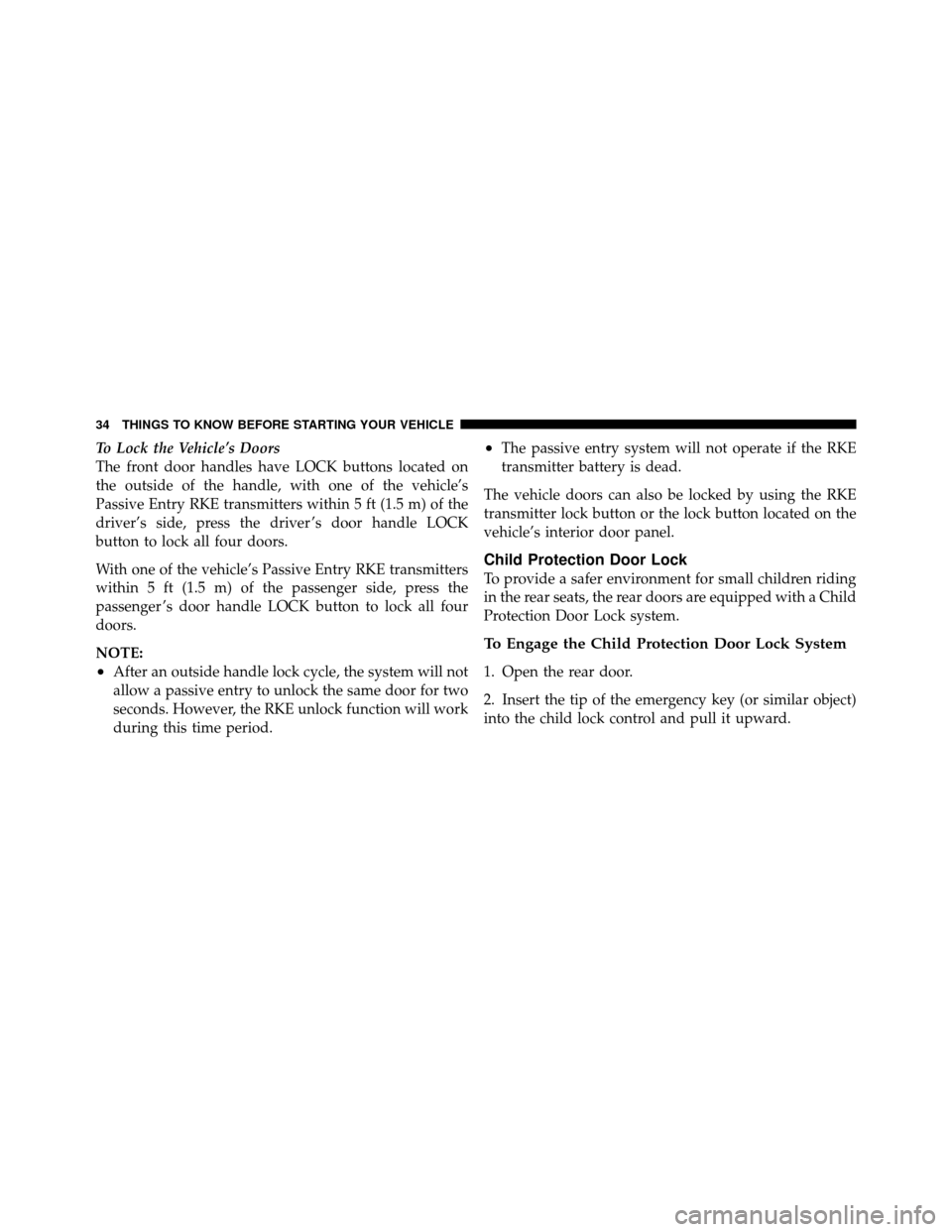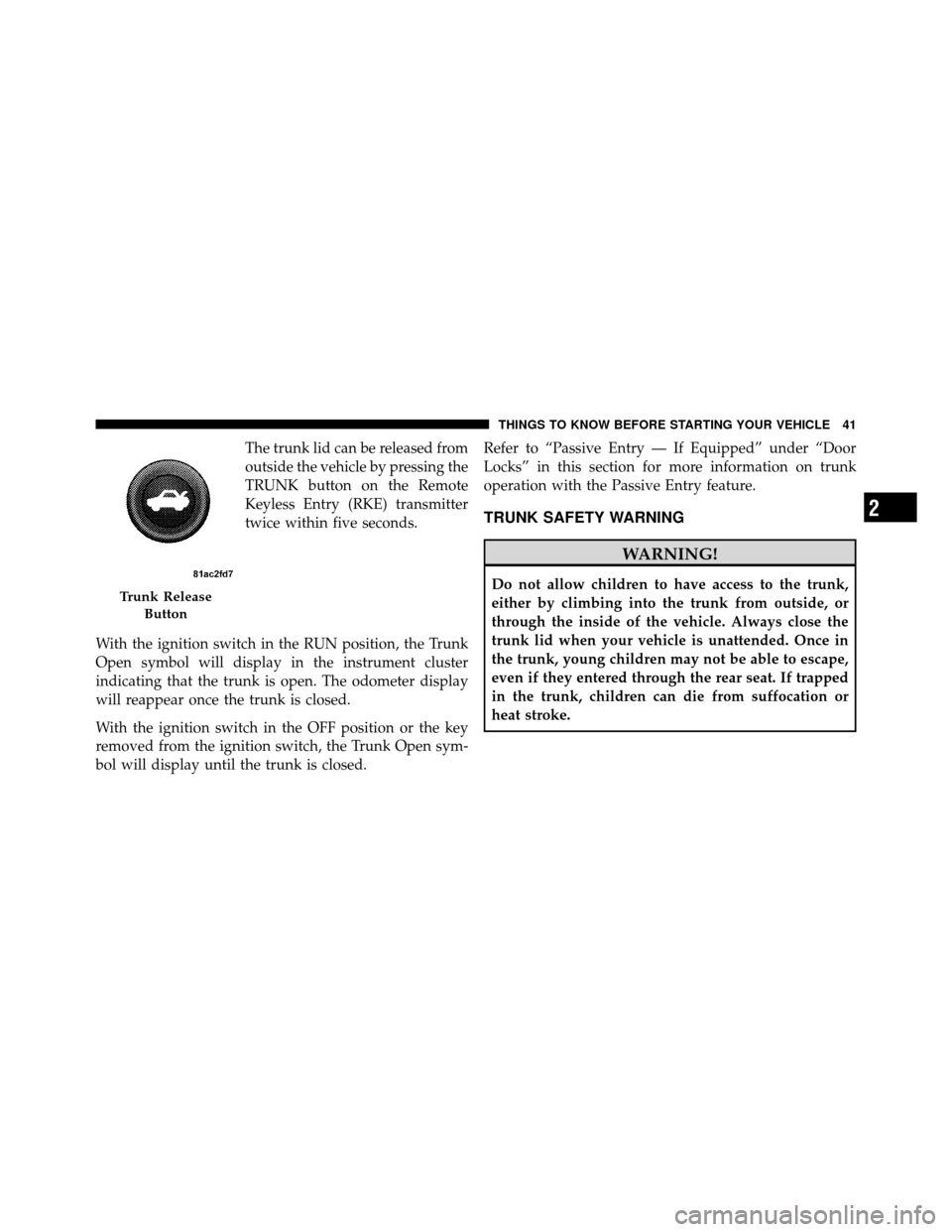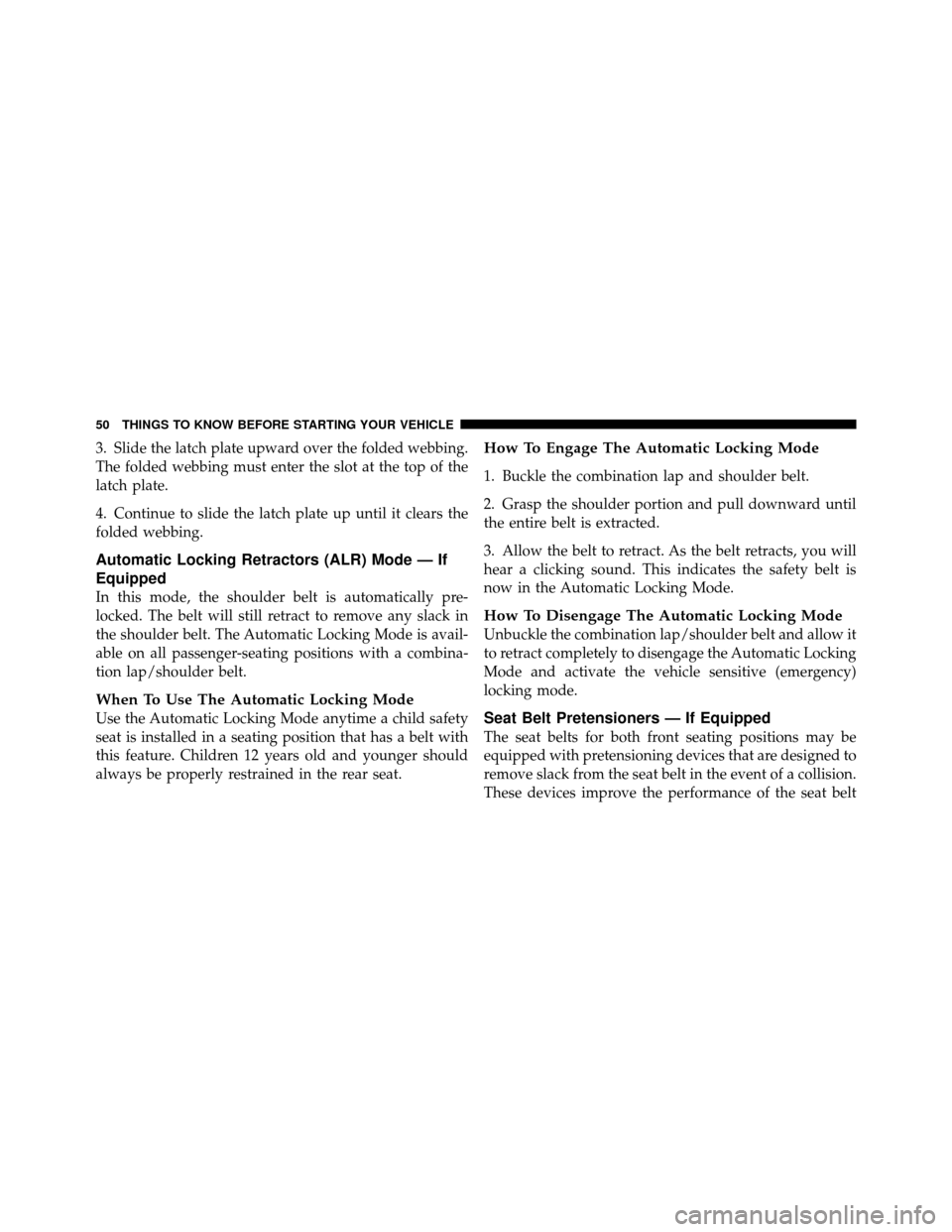Page 11 of 465

▫Using The Panic Alarm ................. 22
▫ Programming Additional Transmitters ...... 23
▫ Transmitter Battery Replacement .......... 23
▫ General Information ................... 24
� Remote Starting System — If Equipped ....... 24
▫ How To Use Remote Start ............... 25
� Door Locks ........................... 27
▫ Manual Door Locks ................... 27
▫ Power Door Locks .................... 28
▫ Passive Entry System — If Equipped ....... 32
▫ Child Protection Door Lock .............. 34
� Windows ............................ 37
▫ Power Windows ...................... 37 ▫
Wind Buffeting ....................... 40
� Trunk Lock And Release ................. 40
� Trunk Safety Warning ................... 41
▫ Trunk Emergency Release ............... 42
� Occupant Restraints ..................... 42
▫ Lap/Shoulder Belts .................... 44
▫ Lap/Shoulder Belt Untwisting Procedure .... 49
▫ Automatic Locking Retractors (ALR) Mode
— If Equipped ....................... 50
▫ Seat Belt Pretensioners — If Equipped ...... 50
▫ Enhanced Seat Belt Use Reminder System
(BeltAlert�) ......................... 51
▫ Seat Belts And Pregnant Women .......... 53
▫ Seat Belt Extender ..................... 53
10 THINGS TO KNOW BEFORE STARTING YOUR VEHICLE
Page 26 of 465
How to Use Remote Start
All of the following conditions must be met before the
engine will remote start:
•Shift lever in PARK
•Doors closed
•Hood closed
•Trunk closed
•Hazard switch off
•Brake switch inactive (brake pedal not pressed)
•Ignition key removed from ignition switch
•Battery at an acceptable charge level
•RKE PANIC button not pressedNOTE:
With Keyless Go, the remote start feature will
operate with the Start/Stop button installed in the igni-
tion switch.
WARNING!
•Do not start or run an engine in a closed garage or
confined area. Exhaust gas contains Carbon Mon-
oxide (CO) which is odorless and colorless. Car-
bon Monoxide is poisonous and can cause serious
injury or death when inhaled.
•Keep Remote Keyless Entry (RKE) transmitters
away from children. Operation of the Remote Start
System, windows, door locks or other controls
could cause serious injury or death.
2
THINGS TO KNOW BEFORE STARTING YOUR VEHICLE 25
Page 29 of 465

If the door lock plunger is down when you shut the door,
the door will lock. Make sure the key is not inside the
vehicle before closing the door.
WARNING!
•For personal security and safety in the event of an
accident, lock the vehicle doors before you drive as
well as when you park and leave the vehicle.
•When leaving the vehicle, always remove the key
from the ignition and lock your vehicle. Unsuper-
vised use of vehicle equipment may cause severe
personal injuries and death.(Continued)
WARNING! (Continued)
•Never leave children alone in a vehicle. Leaving
unattended children in a vehicle is dangerous for a
number of reasons. A child or others could be
seriously or fatally injured. Don’t leave the key in
the ignition or leave a vehicle with Keyless Go in
the ACC or RUN position. A child could operate
power windows, other controls, or move the
vehicle.
Power Door Locks
A power door lock switch is on each front door trim
panel. Use this switch to lock or unlock the doors.
28 THINGS TO KNOW BEFORE STARTING YOUR VEHICLE
Page 35 of 465

To Lock the Vehicle’s Doors
The front door handles have LOCK buttons located on
the outside of the handle, with one of the vehicle’s
Passive Entry RKE transmitters within 5 ft (1.5 m) of the
driver’s side, press the driver ’s door handle LOCK
button to lock all four doors.
With one of the vehicle’s Passive Entry RKE transmitters
within 5 ft (1.5 m) of the passenger side, press the
passenger ’s door handle LOCK button to lock all four
doors.
NOTE:
•After an outside handle lock cycle, the system will not
allow a passive entry to unlock the same door for two
seconds. However, the RKE unlock function will work
during this time period.
•The passive entry system will not operate if the RKE
transmitter battery is dead.
The vehicle doors can also be locked by using the RKE
transmitter lock button or the lock button located on the
vehicle’s interior door panel.
Child Protection Door Lock
To provide a safer environment for small children riding
in the rear seats, the rear doors are equipped with a Child
Protection Door Lock system.
To Engage the Child Protection Door Lock System
1. Open the rear door.
2. Insert the tip of the emergency key (or similar object)
into the child lock control and pull it upward.
34 THINGS TO KNOW BEFORE STARTING YOUR VEHICLE
Page 36 of 465
NOTE:For emergency key information, refer to “A
Word About Your Keys”.
3. Repeat Steps 1 and 2 for the opposite rear door. NOTE:
When the Child Protection Door Lock system is
engaged, the door can be opened only by using the
outside door handle even though the inside door lock is
in the unlocked position.
WARNING!
Avoid trapping anyone in a vehicle in a collision.
Remember that the rear doors can only be opened
from the outside when the child protection locks are
engaged. Failure to follow this warning may result in
serious injury or death.
NOTE:
•After engaging the Child Protection Door Lock sys-
tem, always test the door from the inside to make
certain it is in the desired position.Child Lock Control
2
THINGS TO KNOW BEFORE STARTING YOUR VEHICLE 35
Page 37 of 465
•For emergency exit with the system engaged, move
the door lock plunger to the UNLOCK position, roll
down the window and open the door with the outside
door handle.
To Disengage the Child Protection Door Lock
System
1. Open the rear door.
2. Insert the tip of the emergency key (or similar object)
into the child lock control and pull it downward.3. Repeat Steps 1 and 2 for the opposite rear door.
NOTE:After disengaging the Child Protection Door
Lock system, always test the door from the inside to
make certain it is in the desired position.
Child Lock Control
36 THINGS TO KNOW BEFORE STARTING YOUR VEHICLE
Page 42 of 465

The trunk lid can be released from
outside the vehicle by pressing the
TRUNK button on the Remote
Keyless Entry (RKE) transmitter
twice within five seconds.
With the ignition switch in the RUN position, the Trunk
Open symbol will display in the instrument cluster
indicating that the trunk is open. The odometer display
will reappear once the trunk is closed.
With the ignition switch in the OFF position or the key
removed from the ignition switch, the Trunk Open sym-
bol will display until the trunk is closed. Refer to “Passive Entry — If Equipped” under “Door
Locks” in this section for more information on trunk
operation with the Passive Entry feature.
TRUNK SAFETY WARNING
WARNING!
Do not allow children to have access to the trunk,
either by climbing into the trunk from outside, or
through the inside of the vehicle. Always close the
trunk lid when your vehicle is unattended. Once in
the trunk, young children may not be able to escape,
even if they entered through the rear seat. If trapped
in the trunk, children can die from suffocation or
heat stroke.Trunk Release
Button
2
THINGS TO KNOW BEFORE STARTING YOUR VEHICLE 41
Page 51 of 465

3. Slide the latch plate upward over the folded webbing.
The folded webbing must enter the slot at the top of the
latch plate.
4. Continue to slide the latch plate up until it clears the
folded webbing.
Automatic Locking Retractors (ALR) Mode — If
Equipped
In this mode, the shoulder belt is automatically pre-
locked. The belt will still retract to remove any slack in
the shoulder belt. The Automatic Locking Mode is avail-
able on all passenger-seating positions with a combina-
tion lap/shoulder belt.
When To Use The Automatic Locking Mode
Use the Automatic Locking Mode anytime a child safety
seat is installed in a seating position that has a belt with
this feature. Children 12 years old and younger should
always be properly restrained in the rear seat.
How To Engage The Automatic Locking Mode
1. Buckle the combination lap and shoulder belt.
2. Grasp the shoulder portion and pull downward until
the entire belt is extracted.
3. Allow the belt to retract. As the belt retracts, you will
hear a clicking sound. This indicates the safety belt is
now in the Automatic Locking Mode.
How To Disengage The Automatic Locking Mode
Unbuckle the combination lap/shoulder belt and allow it
to retract completely to disengage the Automatic Locking
Mode and activate the vehicle sensitive (emergency)
locking mode.
Seat Belt Pretensioners — If Equipped
The seat belts for both front seating positions may be
equipped with pretensioning devices that are designed to
remove slack from the seat belt in the event of a collision.
These devices improve the performance of the seat belt
50 THINGS TO KNOW BEFORE STARTING YOUR VEHICLE